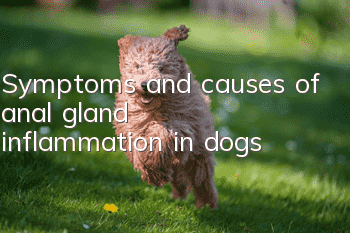Symptoms and causes of anal gland inflammation in dogs

The dog's anal glands, also known as the anal sacs, are a pair of pear-shaped symmetrical glands located at the junction of the anal mucosa and the skin. This part is prone to accumulation of secretions and is one of the sources of dog body odor. In serious cases, It can also induce anal adenitis, seriously affecting the life and health of dogs.
The role of anal glands
The secretion of the dog's anal glands is gray or brown, greasy, smelly, and has the function of lubricating the anus and allowing feces to be discharged smoothly.
Another function is to identify each other between dogs. When dogs meet, they will smell each other's tails to identify each other.
Causes of anal gland inflammation:
It may be caused by anal gland disease. There are anal glands at the end of the rectum, and dogs have two anal glands, distributed on the left and right sides of the anus. When dogs defecate, the anal glands secrete special substances. , this substance acts as a lubricant.
Inflammation of the anal glands may be due to bacterial infection or other reasons. It may also be caused by parasite infection. There are many parasites that dogs can be infected with, such as tapeworms, roundworms, Toxoplasma gondii, etc. These parasites not only cause dogs to rub their butt frequently, but they can also cause a lot of diseases.
Symptoms of inflammation:
When dogs are infected with anal adenitis, they will rub their buttocks, become restless, have a bad mental state, lose their appetite, have constipation or difficulty defecating, or simply pass dry hard feces.
At the same time, the area around the dog's liver portal will be swollen, and the area will be red and itchy. The dog will try to bite the anus in daily life.
When the situation is particularly severe, the dog's anal glands swell and protrude higher than the surrounding skin, making them feel hard to the touch, causing the dog's hind limbs to swing unnaturally. Purulent infection may also lead to eversion of the entire anus, followed by neurological symptoms, paralysis, or paralysis.
Hold the base of the dog's tail with your left hand and expose the anus;
Use your right thumb and index finger to press the four o'clock and eight o'clock positions of the anus. If the anal glands are filled with anal gland fluid, you will feel two bags
Preventing anal gland inflammation:
In daily life, as long as the anal glands of the dog can be squeezed and cleaned in time, the dog can be prevented from being infected with anal adenitis.
For pet dogs that have been infected with anal adenitis, in addition to using the squeezing method to empty the pus in the anal gland sac, they must also be flushed with normal saline or 0.1% potassium permanganate solution, and then inject antibiotics into the anal gland sac.
For the treatment of the skin surface, erythromycin ointment can be applied.
If your dog’s anal adenitis is severe, you should still send it to the doctor. Surgery may be required if necessary.
Note:
When inflammation of the anal glands occurs, the dog will feel unbearable itching of the anus. In order to relieve the itching, the dog will often rub its buttocks. This situation also requires the dog owner to take the dog to the hospital for examination for timely treatment.
- What are the common dog skin diseases in summer? Be careful to prevent them!
- Can the newly purchased dog be vaccinated?
- How to train an Alaskan dog to stop eating poop, a must-read for beginners!
- Are French bulldogs more likely to have dystocia when giving birth to puppies? Bulldogs give birth!
- How to treat arthritis in dogs
- How to trim your dog’s legs and feet
- How to train a dog to pick up things? It doesn’t just require beating and scolding!
- How to train a Schnauzer not to bark? Train Schnauzer’s obedience!
- How to teach a dog to pick up the food bowl? Easily teach a good dog!
- Never feed these foods, as they can easily affect your dog’s health!



